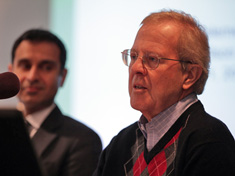-
John Pielemeier: Population, Health, and Environment Programs Need to Prove It Before Becoming Mainstream
April 4, 2014 By Paris Achenbach
A new model of integrated development, combining population, health and environment (PHE) interventions, is efficient, effective, and relatively inexpensive. But more rigorous program evaluations are necessary to prove its value, argues John Pielemeier in this week’s podcast.
A new model of integrated development, combining population, health and environment (PHE) interventions, is efficient, effective, and relatively inexpensive. But more rigorous program evaluations are necessary to prove its value, argues John Pielemeier in this week’s podcast.
Pielemeier, who spent a career evaluating programs at USAID, first evaluated the PHE approach for the Packard Foundation in 2005, and found “early PHE programs – mostly in the Philippines, Madagascar, Guatemala, some in Mexico – they met their objectives, they were inexpensive, many community-mobilization techniques would work, and you could get results in a couple of years.”
PHE programs combine both reproductive health and conservation interventions in areas with rapid population growth and low access to health services, bringing together two sectors that don’t always interact. “These are things that the health people don’t necessarily want to hear, the environment people don’t necessarily want to hear, but people in the field do, the practitioners: It’s cost-effective to have an integrated program,” he says. “You have one boat going out to an island rather than two in a week.”
But because it’s a relatively new approach and more complex than single-sector efforts, program evaluations are especially necessary, Pielemeier says. “Many other [development] programs that are evaluated don’t have that need,” he says, because it’s already been decided they’re effective and useful for various reasons. For example, “when Rajiv Shah goes on the Hill and talks about AID’s Feed the Future program, he doesn’t really have to talk a lot about the nuts and bolts of whether agriculture development can work and whether it can have an impact on farmers in certain parts of the world.”
Pielemeier cites Lynne Gaffikin, a former PHE fellow and USAID technical adviser, saying PHE programs ought to find ways to account for the “interactivity” that makes them special – “evaluate the invisible changes.” To do this, evaluation must be incorporated into programming from the start. “When you design the program you have to have in mind the impact evaluation later on, 5 years or 10 years down the line. You can’t start the process after the program has been running.”
John Pielemeier spoke at the Wilson Center on March 21.
Friday podcasts are also available for download on iTunes.
 A Publication of the Stimson Center.
A Publication of the Stimson Center.




